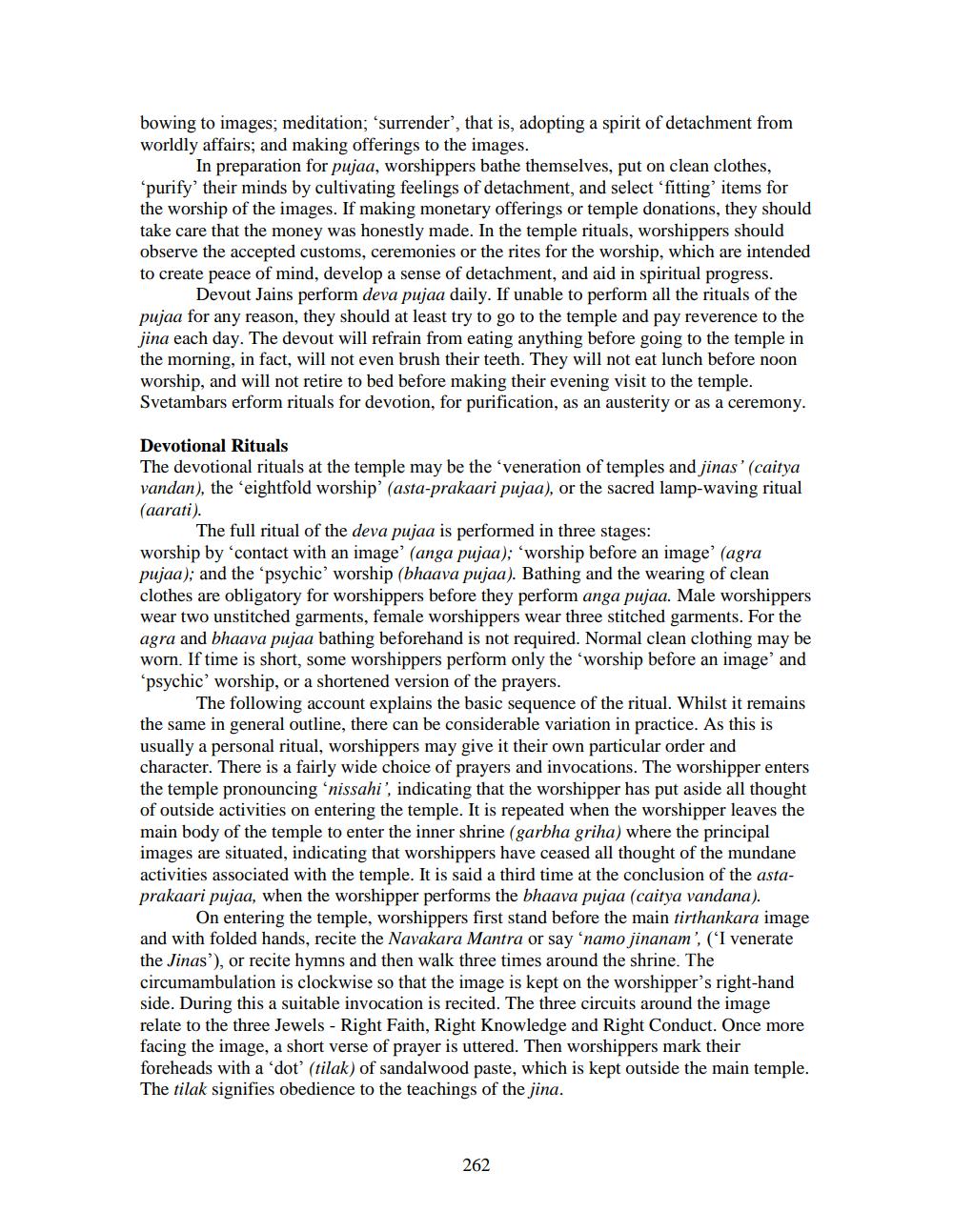________________
bowing to images; meditation; 'surrender', that is, adopting a spirit of detachment from worldly affairs; and making offerings to the images.
In preparation for pujaa, worshippers bathe themselves, put on clean clothes, 'purify' their minds by cultivating feelings of detachment, and select 'fitting' items for the worship of the images. If making monetary offerings or temple donations, they should take care that the money was honestly made. In the temple rituals, worshippers should observe the accepted customs, ceremonies or the rites for the worship, which are intended to create peace of mind, develop a sense of detachment, and aid in spiritual progress. Devout Jains perform deva pujaa daily. If unable to perform all the rituals of the pujaa for any reason, they should at least try to go to the temple and pay reverence to the jina each day. The devout will refrain from eating anything before going to the temple in the morning, in fact, will not even brush their teeth. They will not eat lunch before noon worship, and will not retire to bed before making their evening visit to the temple. Svetambars erform rituals for devotion, for purification, as an austerity or as a ceremony.
Devotional Rituals
The devotional rituals at the temple may be the 'veneration of temples and jinas' (caitya vandan), the 'eightfold worship' (asta-prakaari pujaa), or the sacred lamp-waving ritual (aarati).
The full ritual of the deva pujaa is performed in three stages:
worship by 'contact with an image' (anga pujaa); 'worship before an image' (agra pujaa); and the 'psychic' worship (bhaava pujaa). Bathing and the wearing of clean clothes are obligatory for worshippers before they perform anga pujaa. Male worshippers wear two unstitched garments, female worshippers wear three stitched garments. For the agra and bhaava pujaa bathing beforehand is not required. Normal clean clothing may be wom. If time is short, some worshippers perform only the 'worship before an image' and 'psychic' worship, or a shortened version of the prayers.
The following account explains the basic sequence of the ritual. Whilst it remains the same in general outline, there can be considerable variation in practice. As this is usually a personal ritual, worshippers may give it their own particular order and character. There is a fairly wide choice of prayers and invocations. The worshipper enters the temple pronouncing 'nissahi, indicating that the worshipper has put aside all thought of outside activities on entering the temple. It is repeated when the worshipper leaves the main body of the temple to enter the inner shrine (garbha griha) where the principal images are situated, indicating that worshippers have ceased all thought of the mundane activities associated with the temple. It is said a third time at the conclusion of the astaprakaari pujaa, when the worshipper performs the bhaava pujaa (caitya vandana).
On entering the temple, worshippers first stand before the main tirthankara image and with folded hands, recite the Navakara Mantra or say 'namo jinanam', ('I venerate the Jinas'), or recite hymns and then walk three times around the shrine. The circumambulation is clockwise so that the image is kept on the worshipper's right-hand side. During this a suitable invocation is recited. The three circuits around the image relate to the three Jewels - Right Faith, Right Knowledge and Right Conduct. Once more facing the image, a short verse of prayer is uttered. Then worshippers mark their foreheads with a 'dot' (tilak) of sandalwood paste, which is kept outside the main temple. The tilak signifies obedience to the teachings of the jina.
262




